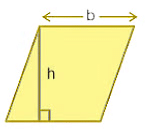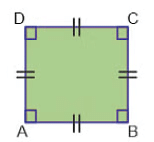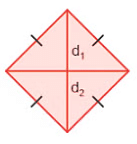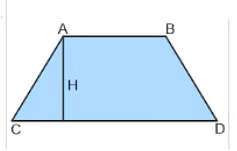Quadrilateral: Overview and Examples | Quantitative Aptitude for SSC CGL PDF Download
| Table of contents |

|
| Quadrilateral |

|
| Types of Quadrilaterals |

|
| Quadrilateral Formula |

|
| Perimeter of Quadrilateral |

|
| Area of Quadrilateral |

|
| Sides and Angles of Quadrilaterals |

|
Any four points that don't lie on the same line make a quadrilateral; this shape goes by different names based on its form. A quadrilateral is a flat geometric figure with four sides and four corners. Understanding quadrilaterals is essential for various exams like SSC, Railways, AAI, and academic tests. A quadrilateral encompasses shapes like parallelograms, rectangles, squares, rhombuses, trapeziums, and kites, each with unique properties and formulas. These geometric concepts are crucial for competitive exams and academic studies.
Quadrilateral
In geometry, a quadrilateral is a shape with four sides, four angles, and four vertices. It's formed by connecting four points where any three points are not in a straight line. Several types of quadrilaterals exist, including a square, rectangle, parallelogram, rhombus, trapezium, and kite. We'll explore each type in the sections ahead.Types of Quadrilaterals
The term Quadrilateral originates from a Latin term, where Quadra signifies four and Latus means sides. A quadrilateral can have four sides that are either the same or different. Examples of quadrilaterals include rectangle, square, trapezoid, and kite, which typically exhibit a four-sided structure.Various types of quadrilaterals are elaborated upon below:
Parallelogram

Definition: A quadrilateral with two pairs of opposite sides that are parallel and equal in length.
Properties:- Opposite sides are parallel (AB || CD, BC || AD).
- Opposite sides are equal in length (AB = CD, BC = AD).
- Diagonals bisect each other.
- The sum of any two adjacent angles is 180 degrees (∠A + ∠B = 180°, ∠B + ∠C = 180°, etc.).
Rectangle

Definition: A parallelogram where each angle measures 90 degrees.
Properties:- Opposite sides are parallel (AB || CD, BC || AD).
- Opposite sides are equal in length (AB = CD, BC = AD).
- All angles are equal to 90 degrees (∠A = ∠B = ∠C = ∠D = 90°).
- Diagonals bisect each other and are equal in length.
Square

Definition: A parallelogram with all sides equal and each angle measuring 90 degrees.
Properties:- All sides are equal in length (AB = BC = CD = DA).
- Opposite sides are parallel (AB || CD, BC || AD).
- All angles are equal to 90 degrees (∠A = ∠B = ∠C = ∠D = 90°).
- Diagonals bisect each other at right angles and are equal in length.
Rhombus

Definition: A parallelogram where all sides are equal, and the diagonals bisect each other at right angles.
Properties:- All sides are equal in length (AB = BC = CD = DA).
- Opposite sides are parallel (AB || CD, BC || AD).
- Opposite angles are equal.
- Diagonals bisect each other perpendicularly.
Trapezium
 Definition: A quadrilateral with only one pair of opposite sides that are parallel.
Definition: A quadrilateral with only one pair of opposite sides that are parallel.
- Only one pair of opposite sides are parallel (AB || CD).
- The non-parallel sides are called the legs of the trapezium.
- The diagonals do not bisect each other in the same ratio.
Kite
 Definition: A quadrilateral with two pairs of adjacent sides that are equal in length.
Definition: A quadrilateral with two pairs of adjacent sides that are equal in length.
Properties:
- Two pairs of adjacent sides are equal (AB = AD, BC = CD).
- The diagonals intersect at right angles.
- One of the diagonals bisects the other.
Quadrilateral Formula
- Shapes: We previously talked about square, rectangle, parallelogram, rhombus, trapezium, and kite with a detailed illustration.
- Formulas: Let's now understand the fundamental equations connected to these shapes. Area and perimeter represent the basic formulas for different four-sided figures. The following are the formulas:
- Area: The space inside a shape.
- Perimeter: The total length of the boundary of a shape.
Perimeter of Quadrilateral
- The perimeter refers to the total distance around the edge of any flat shape.
- In a four-sided shape (quadrilateral), the perimeter is the sum of all four side lengths.
- Various types of quadrilaterals have different perimeters.
Note: The perimeter is the total distance around the edge of a 2D shape, like a square or rectangle. For a quadrilateral, which is a shape with four sides, the perimeter is the sum of all four side lengths. Different types of quadrilaterals have different perimeters based on their side measurements.
| Shape | Formula for Perimeter |
| Parallellogram |
|
| Rectangle |
|
| Square |
|
| Rhombus |
|
| Trapezium |
|
| Kite |
|
Area of Quadrilateral
- Square: All sides are equal. Area = side x side
- Parallelogram: Opposite sides are parallel. Area = base x height
- Rectangle: Opposite sides are equal and all angles are 90 degrees. Area = length x width
- Rhombus: All sides are equal, opposite angles are equal. Area = (diagonal1 x diagonal2) / 2
- Trapezium: One pair of parallel sides. Area = 0.5 x (sum of parallel sides) x height
- Kite: Two pairs of adjacent sides are equal. Area = 0.5 x (diagonal1 x diagonal2)
| Shape | Area |
| Parallelogram | b × h (base × height) |
| Rectangle | Length × Breadth ( L × B) |
| Square | a2 (side length squared) |
| Rhombus | 1/2×d1×d2 (where length of two diagonals of the is d1 and d2) |
| Trapezium | 1/2×(Addition of lengths of parallel sides)×h (where, ‘h’ represents the height) |
| Kite | 1/2×Diagonal1×Diagonal2 |
Sides and Angles of Quadrilaterals
Learn about key facts on sides and angles of parallelogram, rectangle, square, rhombus, and trapezium.- Opposite sides run alongside each other and look the same with lines from corner to corner cutting each other into two.
- The angles have different measurements, but the opposite angles are of the same size.
| Shape | Sides | Angles |
| Parallelogram |
|
|
| Rectangle |
|
|
| Square |
|
|
| Rhombus |
|
|
| Trapezium |
| – |
| Isosceles trapezium |
| – |
 |
Download the notes
Quadrilateral: Overview and Examples
|
Download as PDF |
Properties of Quadrilaterals
Common Properties of Quadrilaterals:- Quadrilaterals have four sides.
- Quadrilaterals have four vertices.
- Quadrilaterals have two diagonals.
- The total of all interior angles is 360 degrees.
- Rectangle
- Parallelogram
- Rhombus
- Square
- Trapezoid
- Kite
| Shape | Properties |
| Square |
|
| Rectangle |
|
| Rhombus |
|
| Parallelogram |
|
Trapezium |
|
Kite |
|
Solved Examples on Quadrilateral
- A polygon is a flat shape with many sides. For instance, a shape with three sides is called a 3-gon, and one with four sides is known as a 4-gon.
- This article focuses on quadrilaterals, which are polygons with four sides. The total angles inside a quadrilateral add up to 360 degrees.
- Here are some solved examples of quadrilaterals.
Example 1 : Obtain the perimeter of the quadrilateral with sides 6 cm, 7 cm, 8 cm and 13 cm.
 View Answer
View AnswerSolution: Given, the measures of 4 different sides are 6 cm, 7 cm, 8 cm, and 13 cm.
- As known to us the perimeter will be equivalent to the summation of the length of all four sides. That is:
- P(perimeter)= 6 cm+7 cm+8 cm + 13 cm= 34 cm
Example 2 : If the two diagonals of a kite are of length 22 cm and 6 cm then what is the respective area.
 View Answer
View AnswerSolution: The area of a Kite=1/2×Diagonal1×Diagonal2 =
Hence, the area of a Kite=66 square metres.
Example 3 :Determine the perimeter of the parallelogram whose opposite sides are 13 cm and 6 cm respectively.
 View Answer
View AnswerSolution: As per the property of a parallelogram, the opposite sides have identical lengths. Thus,
Perimeter = 13 cm + 6 cm + 13 cm + 6 cm = 38 cm
Example 4 : What is the base of a rectangle having an area of 72 square units and the height is 8 units.
 View Answer
View AnswerSolution:
Given data:
- Area = 72 square units
- Height = 8 units
- Area of rectangle = Base × Height
- 72 = Base × 8
- Base = 72/8 = 9 units
|
315 videos|182 docs|185 tests
|
FAQs on Quadrilateral: Overview and Examples - Quantitative Aptitude for SSC CGL
| 1. What are the different types of quadrilaterals? |  |
| 2. What is the formula to find the perimeter of a quadrilateral? |  |
| 3. How do you calculate the area of a quadrilateral? |  |
| 4. What is the relationship between the sides and angles of a quadrilateral? |  |
| 5. Can a quadrilateral have equal sides and angles? |  |



























